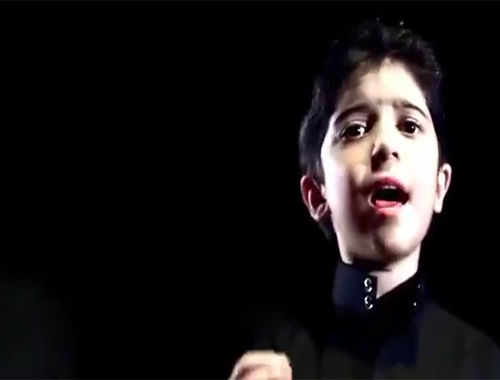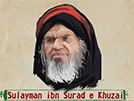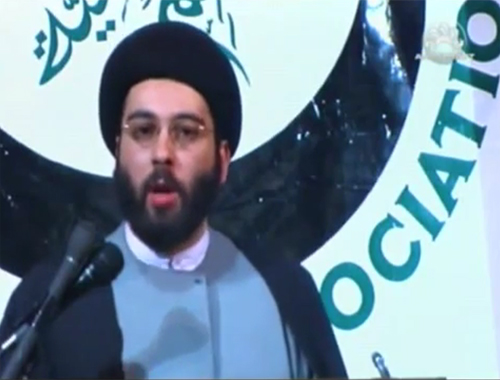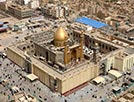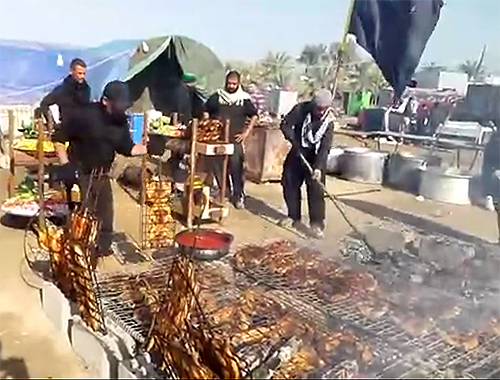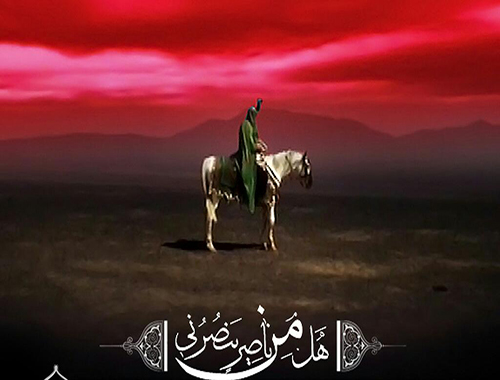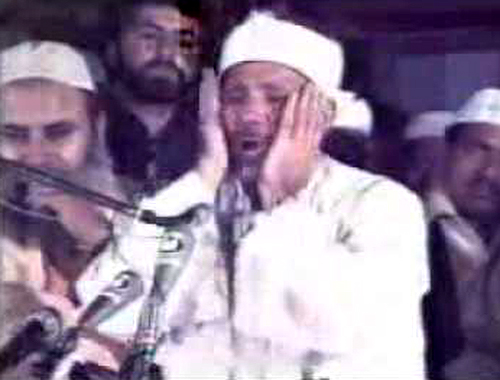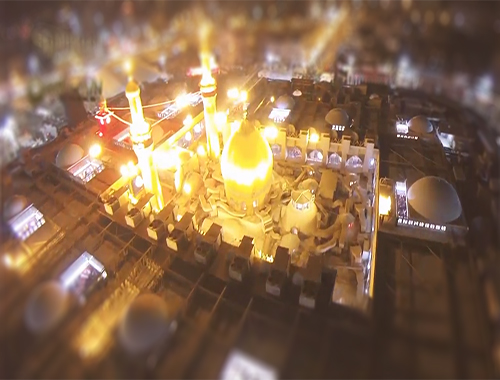Chapter 3-The Shrine of Lady Fatima Masuma (A)
- Details
- Hits: 6777
Chapter 3
The Shrine of Lady Fatima Masuma (A)
--------------------------------------------------------------------------------
3.1 - A brief history
After the burial of Lady Fatima Masuma (A), MÅ«sÄ ibn Khazraj placed a ceiling made of wicker over the grave, which remained unchanged until Zaynab, daughter of Imam al-TaqÄ« (A), came to Qum and had a dome built on the grave.[75] The dome was built of bricks and mortar. This event occurred in the middle of the third Islamic century.
After the passing of some time, two other domes were built near the first dome and it was under the third dome that Zaynab, daughter of Imam al-Taqī (A) was herself buried.
These three domes remained till the year 457 A.H, when the vizier of Tughrul the Great, MÄ«r AbÅ« al-Fadl al-`ĪrÄqÄ«, at the urging of the great scholar, Shaykh TÅ«sÄ« (d.460 A.H) built one high dome in place of the three domes.
3.2 - During the reign of the Safavids
From the time of the replacement of the three domes by one, until the time of the reign of the Safavids,[76] the condition of the shrine of Lady Fatima Masuma (A) remained somewhat the same. At this time there was no chamber above the grave, nor any porches or courtyards.
In the year 925 A.H ShÄh IsmÄ`Ä«l I built a gold porch on the North side and laid the foundation of what is now called the old courtyard. After him, Shah TahmÄsb I, built a burial chamber, with glazed tiles, around the holy grave. He also built a porch on the South side of the grave (in the old courtyard).
In the year 1077 A.H ShÄh SafÄ«y built a courtyard for women, in the south of the threshold of the grave, which is now the area surrounding the enclosed area of the Mosque of TabÄtabÄ’Ä«. This courtyard is the burial place for ShÄh `AbbÄs and ShÄh SulaymÄn and ShÄh SultÄn Husain.
In the time of the reign of ShÄh `AbbÄs, the burial chamber was covered with white steel and the present chamber contains some of the same steel with sheets of silver added to it.
3.3 - During the reign of the QÄjÄrs
After the reign of the SafavÄ«ds, further repairs to the shrine of Lady Fatima Masuma (A) did not take place until the time of the reign of the QÄjÄrs in Iran.[77]
In the year 1218 A.H Fath Ali ShÄh QÄjÄr made a dome of gold using 12000 gold-covered bricks. In the year 1236 A.H, the mosque known as Masjid-e BÄlÄ Sar [the mosque at the head of the holy body of Lady Fatima Masuma (A)], was built.
In the year 1276 A.H, the porch of ShÄh IsmÄ`Ä«l SafavÄ« was decorated with gold and in the year 1275 A.H the steel burial chamber of ShÄh `AbbÄs was remade using silver.
Towards the end of the 13th century A.H, the foundation for a new, bigger courtyard was laid, and the building was completed during the reign of NÄsir al-DÄ«n ShÄh, in the year 1303 A.H.[78]
3.4 - After the victory of the Islamic Revolution
During the course of its history, a lot of elegant and beautiful decorative work, using different materials and scripts has been added to the shrine of Lady Fatima Masuma (A), which we are unable to go into in this book.
After the victory of the Islamic Revolution of Iran, the leader, Grand Ayatollah Khomeini, authorised a number of important changes to the layout and organisation of the holy shrine. More facilities for pilgrims were introduced. The Masjid-e A`Ä‘am, built by the Grand Ayatollah Burujadi, was annexed to the holy shrine. The shrine was enlarged and currently this expansion project is continuing. Other changes were also been made, but again the details lie outside the scope of this book.
3.5 - The construction of the burial chamber to the present time
In the year 605 A.H, AmÄ«r Ahmad ibn IsmÄ`Ä«l commissioned the leading glass tile-maker and engraver of the time, Muhammad ibn AbÄ« TÄhir KÄshÄ«kÄr QummÄ«, to decorate the tomb of Lady Fatima Masuma (A). The work was completed in 8 years.
In the year 950 A.H, ShÄh TahmÄsb SafavÄ«, erected a burial chamber made of bricks and decorated with tiles of seven colours, around the tomb. The chamber had a screen through which pilgrims could see the tomb and put in donations and petitions into the chamber.
After some years, by the order of ShÄh `AbbÄs, a steel grill was placed in front of the bricked burial chamber.
In the year 1230 A.H, Fath Ali ShÄh QÄjÄr, covered this steel grill with silver. This remained in place until it showed signs of deterioration and in the year 1280 A.H, a new chamber, using silver from the old one, as well as additional silver from the treasury, was erected, entirely replacing the old one.

The Old Burial Chamber (Darīh) of Lady Fatima Masuma (A)
This new chamber remained for a long time over the tomb of Lady Fatima Masuma (A), being repaired as needed, until the year 1368 A.H. Then, by the order of the Custodian of the time, a newer burial chamber, with a different shape was erected in place of the former one.
After over 40 years, due to the increase in the numbers of visitors to the holy shrine, and natural deterioration, the grills of the burial chamber became corroded.
Additionally, the wooden interior of the chamber, which had been in place for over a hundred years, had become badly damaged. More importantly, the constant washing of the chamber with rose water had given it a red tinge, and cracks were found in its foundations. The considerable damage to the chamber necessitated a replacement.
The custodian of the shrine, Ayatollah Mas`Å«dÄ«, made the decision in the year 1415 A.H to replace the burial chamber. For this purpose, the leading expert in the field, Ä€ghÄ Husain Parwaresh IsfÄhÄnÄ« was commissioned to design a new chamber. He died before he could finish the work and it was completed by Ä€ghÄ Muhammad Husain `AbbÄspÅ«r IsfÄhÄnÄ«.

The New Burial Chamber (Darīh) of Lady Fatima Masuma (A)
In this last and latest version of the burial chamber several changes have been made:
- the poems and verses that were inscribed on the upper part of the old chamber were collected and inscribed in gold lettering to go at the top of the new chamber.
- the section between the top of the chamber and the area accessible to the pilgrims, which was formerly made of silver, was replaced with gold.
- The upper chambers and grills which contained over 5000 spheres and tubes were all replaced and made thicker and sturdier. For this section alone, over 200 kilograms of pure silver was used.
- The old wooden foundations, which are not visible, were also replaced with better and more hardwearing wood.
The chamber itself is 4 meters high, 5.25 meters long and 4.73 meters wide. Although outwardly the latest chamber does not seem much different from the former one, it has been made much stronger, sturdier and durable. The total cost of these renovations to the chamber was approximately 3 billion Rials (nearly £250,000).
The project took 5 years to complete. However, by the swift work of the builders who worked three shifts round the clock, the installation of the new chamber was completed in just one month, thereby not unduly inconveniencing the pilgrims.
The new burial chamber was re-opened to the public on the day of Ghadīr 1422 A.H, by Grand Ayatollah Muhammad Taqī Bahjat.
3.6 - The holy shrine at the present time
The total area of the grounds of the shrine is over 13,000 square meters, which includes the burial chamber (darÄ«h), the porches, the halls, the three courtyards and the two earlier mosques (TabÄtabÄ’Ä« and BÄlÄ Sar).
More recently, a new mosque (Masjid-e A`Ä‘am), which was built by the great Marja’, Grand Ayatollah Sayyid Husain BurÅ«jirdÄ«, was annexed to the Haram. Its dimensions alone exceed 25,000 square meters. His tomb is situated at the entrance of the mosque that he built.
In this mosque, in the mornings, the leading scholars of today give classes to advanced students. The mosque is also used for all the congregational prayers.
Between Masjid-e A`Ä‘am and the darih of Lady Fatima Masuma (A) is situated the mosque known as Masjid-e BÄlÄ Sar. Within this mosque are buried several great scholars of the past, including:
- Grand Ayatollah Shaykh `Abd al-Karīm HĒirī.
- Grand Ayatollah Shaykh Muhammad Ali ArÄkÄ«,
- Grand Ayatollah Sayyid Muhammad RidÄ GulpaygÄnÄ«
- Grand Ayatollah Sayyid Sadr al-DÄ«n Sadr
- Grand Ayatollah Sayyid Muhammad TaqÄ« KhÄnsÄrÄ«.
- Grand Ayatollah Sayyid Muhammad Hasan ShirÄzÄ«
- AllÄmah Sayyid Muhammad Husain TabÄtabÄ`Ä«
- ShahÄ«d Shaykh MurtadÄ MutahharÄ«

The Graves of Some Grand Ayatollahs in Masjid BÄlÄ Sar, in the Shrine of Lady Fatima Masuma (A)
3.7 - The golden dome
In 1218 A.H, Fath Ali ShÄh QÄjÄr commissioned the original golden dome of Lady Fatima Masuma (A), using 12000 gold-covered bricks. The dome remained unchanged for over 200 years.
In the year 1421 A.H, plans were made to change it. The event took place as follows:
Ayatollah Mas’udi, the custodian of the holy shrine, narrates:
“One day I went near the dome to study its condition closely. I found that some of the gold had come off and the bricks under it were worn away.
Specialists were called for their opinion on the matter and, after some discussion, they advised that the dome in its present state was not repairable. It needed to be completely covered with copper first, before gold could be placed over it.
It was calculated that the gold that would be recovered from the present dome would be about 20 kilograms, but the restoration would require 10 tonnes of copper and 200 kilograms of 24 carat gold, the cost of which would be about 30 billion Rials (approximately 3 million pounds)
In a special meeting the matter of the cost was brought forth for discussion and I said: “I cannot undertake the responsibility for procuring this cost and furthermore my age does not allow me to take on this great task.”
The discussion took place in a private meeting with only those present in the meeting having knowledge of it.
Some days later, I went to Ayatollah al-`UÄ‘mÄ, Muhammad TaqÄ« Bahjat to discuss the matter of the reconstruction of the dome. I had not previously informed him of the reason for my visit.
To my great surprise, after greeting me and asking me about my health, he himself said: ‘Why is the dome of Lady Masuma (A) not being fixed, the dome is very worn, start the work, God will send the money needed for this work and He will also grant you a long life.’
I was indeed surprised because the matter of the reconstruction, the problem of the cost involved and my own reservations, were not public knowledge. It was a matter which no one other than those present in the initial meeting knew of.
I answered: ‘The cost of this work is very high and at the present time we do not have the necessary funds.”
After a few days, Ayatollah Behjat contacted me and said, “Start the work, God will send the money for it. Meanwhile, inform the Leader of Iran, Ayatollah KhÄmene’Ä«.”
I went to the office of the Leader and explained the matter to him. He said, “I agree with whatever Ayatollah Behjat recommends.”
After the approval of the Leader, I decided to proceed with the reconstruction of the dome. Ayatollah Bahjat gave me 100 million Rials. and an amount of gold to start the work.” [79]

The Old Golden Dome of the Shrine of
Lady Fatima Masuma (A)
This work commenced at the beginning of the Iranian New Year two years ago and is presently continuing apace. It is aimed to complete the task in the year 1426 A.H, (2005 C.E), InshÄ Allah. Continuous progress reports are published in the monthly newspaper of the Haram, PayÄm-e Ä€stÄn.
The importance of maintaining and looking after the holy shrines is underlined by the following tradition, where the Holy Prophet (S) said to Imam Ali (A):
يا عَليّ٠مَنْ عَمَّرَ Ù‚ÙبورَكÙمْ وَتَعاهَدَها، ÙَكَانّÙما اَعَانَ سÙلَيْمانَ ابْنَ داوÙدَ عَلى بÙناء٠بَيْت٠الْمÙقَدَّس
“O Ali, whoever maintains, repairs and reconstructs your tombs, and is constantly engaged in this task, it is as if he has helped SulaymÄn ibn DÄwÅ«d (A) build the Bayt al-Muqaddas.”[80]
3.8 - Inscriptions within the shrine
On the walls of the buildings within the shrine are inscriptions of poems, traditions and verses from the Qur’an in different scripts and using different materials. These decorate the walls, porticos and minarets. A small sample of some of these inscriptions is given below so as to familiarise the reader with the shrine and its markings.
3.9 - Inscriptions within the dome
On the inside of the dome, and within the burial chamber that was fixed in place in the year 1240 A.H, there are inscribed poems in Nasta`lÄ«q script, by Fath ‘Ali KhÄn SabÄ. Both poems are in praise of Lady Fatima Masuma (A) and the Ahl al-Bayt (A).
In the inside of the dome, a gold balcony has been constructed using glazed multicoloured tiles.
On a background of cobalt blue, in the Thulth script, the following tradition has been inscribed in Arabic: (this tradition has been reported by both Shi`a and Sunni scholars)
روى الزّمخشري ÙÙŠ تÙسيره الموسوم بالكشّا٠والثّعلبي ÙÙŠ تÙسيره الموسوم بكش٠البيان، عن رسول الله (ص) قال: ألا ومن مات على Øبّ آل Ù…Øمّد مات شهيداً، ألا ومن مات على Øبّ آل Ù…Øمّد مات مغÙوراً، ألا ومن مات على Øبّ آل Ù…Øمّد مات مؤمناً متكمّلاً، ألا ومن مات على Øبّ Ù…Øمّد وآل Ù…Øمّد بشّره ملك الموت ونكير ومنكر بالجنّة، ألا من مات على Øبّ Ù…Øمّد وآل Ù…Øمّد زÙÙ‘ الى الجنّة، ألا من مات على Øبّ Ù…Øمّد وآل Ù…Øمّد ÙØªØ Ø§Ù„Ù„Ù‡ له ÙÙ‰ قبره بابين الى الجنّة، ألا ومن مات على Øبّ Ù…Øمّد وآل Ù…Øمّد جعل الله قبره مزار ملائكة الرّØمة، ألا ومن مات على بغض Ù…Øمّد وآل Ù…Øمّد جاء يوم القيامة مكتوب بين عينيه آيس من رØمة الله، ألا ومن مات على بغض آل Ù…Øمّد مات كاÙراً، ألا ومن مات على بغض آل Ù…Øمّد لم يشمّ رائØØ© الجنّة.
The translation of the text is as follows:
ZamakhsharÄ« in his al-KashshÄf and Tha`labÄ« in his Kashf al-BayÄn [two great Sunni scholars] have both narrated from the Messenger of Allah, who said:
“Be aware that whoever dies having love for the family of Muhammad dies a martyr.
Be aware that whoever dies having love for the family of Muhammad dies forgiven.
Be aware that whoever dies having love for the family of Muhammad dies with faith and perfection.
Be aware that whoever dies having love for Muhammad and the family of Muhammad, the angel of death and the two angels, Nakīr and Munkar will give him good tidings of Heaven.
Be aware that whoever dies having love for Muhammad and the family of Muhammad, will be raised to Heaven.
Be aware that whoever dies having love for Muhammad and the family of Muhammad, Allah will open two doors leading into Heaven in his grave.
Be aware that whoever dies having love for Muhammad and the family of Muhammad, Allah will make his grave a place of pilgrimage for the angels of Mercy.
Be aware that whoever dies having enmity for Muhammad and the family of Muhammad, on the Day of Judgement, in between his two eyes will be written, “He has no hope of receiving the mercy of Allah.”
Be aware that whoever dies having enmity for the family of Muhammad, dies an unbeliever (KÄfir).
Be aware that whoever dies having enmity for the family of Muhammad will not even smell the fragrance of Heaven.”
Then under it, has been written:
اَللّهÙمَّ صَلّ٠عَلَى الْمÙصْطَÙÙ‰ Ù…ÙØَمَّدÙØŒ والمرتضى عليّÙØŒ والبتول Ùاطمة، والسّبطين الØسن والØسين، وزين العابدين علي، والباقر Ù…Øمّد، والصّادق جعÙر، والكاظم موسى، والرّضا علي، والتّقي Ù…Øمّد، والنّقي علي، والزكيّ الØسن، والØجّة القائم المهدي صاØب الزّمان، ائمَة الهÙدى ÙˆÙ…ØµØ§Ø¨ÙŠØ Ø§Ù„Ø¯Ù‘Ø¬Ù‰ØŒ بهم أتولّى، ومن أعدائهم اتبرّءÙ
Which translates as:
“O Allah! Send Your blessings on al-MustafÄ Muhammad, on al-MurtadÄ Ali, on al-BatÅ«l Fatima, on the two grandsons [of the Prophet], Hasan and Husain, on Zayn al-`Ä€bidÄ«n Ali, on al-BÄqir Muhammad, on al-SÄdiq Ja`far, on al-KÄzim MÅ«sÄ, on al-RidÄ Ali, on al-TaqÄ« Muhammad, on al-NaqÄ« Ali, on al-ZakÄ« Hasan and on al-Hujjat al-QÄ’im Mahdi, Master of the Time. These are the Imams of guidance and the lights in the darkness; I accept their guardianship and maintain enmity with their enemies.”
3.10 - Inscriptions on the tomb
The tomb is built up with bricks, which are decorated with different coloured glass tiles, and on them are inscribed:
§ The Verse al-KursÄ« (2:255), written in Naskh script
§ Various verses, written in Naskh script, in gold lettering
§ Various verses, written in KÅ«fÄ« script
§ The Chapter al-Mulk, written in Naskh script, in gold lettering
§ Other verses from the Qur’an.
Under the inscriptions, it is written in Naskh script: “Written and inscribed by Muhammad ibn AbÄ« TÄhir ibn AbÄ« al-Husain.”

The Tomb of Lady Fatima Masuma (A)
On the glass tiles around the grave from above to below are engraved:
§ The Chapter YÄsÄ«n,
§ The Chapter al-RahmÄn,
§ The Chapter al-Mulk,
§ The Chapter Hal AtÄ
§ The Chapter al-Qadr
and also several traditions from the Prophet (S), which are reproduced below:[81]
Tradition 1:
قالَ النَّبÙÙŠ (ص): مَنْ ÙƒÙŽÙÙ‘ÙŽ Ù„Ùسانَه٠عَنْ اَعْراض٠النّاسÙØŒ اَقالَه٠الله٠عَثْرَتَه٠يَوْمَ الْقيامَةÙ
“Whoever guards his tongue from dishonouring the people, on the Day of Judgement, God will forgive his lapses.”
Tradition 2:
مَنْ Ùَرَّقَ بَيْنَ وَالÙدَة٠وَوَلَدÙها، Ùَرَّقَ الله٠بَيْنَه٠وَبَيْنَ الْجَنَّةÙ
“Whoever causes a separation between a mother and her child, God will cause a separation between him and Heaven.”
Tradition 3:
ØÙسْن٠السّؤال٠نÙصْÙ٠الْعÙلْمÙ
“A good question is half of learning.”
Tradition 4:
الله٠تَعالى عَوْن٠الْعَبْد٠ما دامَ الْعَبْد٠ÙÙŠ عَوْن٠اَخيهÙ
“God, Most High, helps His servant so long as the servant helps his brother.”
3.11 - Miracles that have occurred at the holy shrine
Numerous miracles have taken place at the shrine of Lady Fatima Masuma (A) over the centuries. Pilgrims come here for the blessing of the noble lady and are not disappointed. Miraculous events are scrupulously recorded in a special office within the shrine and details of some of them are regularly published in issues of the shrine’s monthly newspaper, the PayÄm-e Ä€stÄn.
There are so many miracles which have occurred at this holy site, that it would not be possible to mention them all. Perhaps the only non-Ma`sum whose shrine is the site for similar occurrences is Hadzrat `AbbÄs (A) in KarbalÄ and Lady Zaynab (A) in Damascus. Here, a few brief examples are mentioned:
1. Cure of a Serious Illness:
A man by the name of MÄ«rzÄ AsadullÄh, who was a guard at the shrine of Lady Fatima Masuma (A), developed gangrene in one foot. It had become so bad that the doctors advised amputation of the foot to halt the progress of the disease.
The night before the scheduled amputation, MÄ«rzÄ AsadullÄh decided to go to the shrine of Lady Fatima Masuma (A) and pray for a miracle. He prayed earnestly in the shrine late into the night, until the shrine was shut. He remained inside weeping and beseeching the noble lady for assistance.
Next day early morning, while it was still dark, the guards who had come to reopen the doors of the Shrine heard him shouting, “Open the door, the Lady has been kind to me, through her intercession I have been cured.”
They opened the doors and found MÄ«rzÄ AsadullÄh standing there, completely cured. He gave the following account of the events leading up to his cure, which have been recorded in his words:
“A noble lady approached me and asked: ‘What is it that you want?’ I replied, ‘Cure me of this illness in my foot; ask Allah for my cure or my death!’
Then that noble Lady rubbed the corner of her scarf on my foot a few times and said: ‘Allah has cured you’. Immediately, I felt better and the constant pain in my foot disappeared. I asked her who she was, and she replied: ‘How do you not recognize me, while you are one of the guards of my shrine? I am Fatima, daughter of MÅ«sÄ ibn Ja`far.’”[82]
2. Seeking guidance from Lady Fatima Masuma (A) by MullÄ SadrÄ:
Sadr al-DÄ«n Muhamad ibn IbrÄhÄ«m ShÄ«rÄzÄ«, well known as MullÄ SadrÄ or Sadr al-Muta’allihÄ«n, was a great scholar of philosophy during the time of the Safavids. After the death of his father, MullÄ SadrÄ moved to a village called “Kahak” (near Qum), where he spent a lot of his time in deep thought and contemplation.
MullÄ SadrÄ would continuously go to Makka for pilgrimage and it was on his return from the seventh of these journeys that he died in Basra, in the year 1050 A.H.
His works include: Al-Hikmat al-Muta‘ÄlÄ«yat fÄ« al-AsfÄr al-‘AqlÄ«yah al-Arbi‘at (The Transcendent Wisdom Concerning the Four Intellectual Journeys), KitÄb al-MashÄ‘ir (The Book of Metaphysical Penetrations) and Al-Hikmat al-‘ArshÄ«yat (The Wisdom of the Throne).
Whenever MullÄ SadrÄ encountered any scholarly problems he would travel to Qum and pay homage to Lady Fatima Masuma (A) and through her guidance, he would be able to solve these problems.[83]
The late Grand Ayatollah Sayyid ShahÄb al-DÄ«n Mar`ashÄ« NajafÄ« has said, “Whenever MullÄ SadrÄ faced a philosophical problem or something which he had difficulty in understanding, he would come to the shrine of Lady Fatima Masuma (A) and ask for her assistance. With her help, he would invariably find the answers which he was searching for.” [84]
3. The resolution of the difficulties of Ayatollah Najafī by Lady Fatima Masuma (A):
The late Grand Ayatollah Sayyid ShahÄb al-DÄ«n Mar`ashÄ« NajafÄ« narrates, “When I was young, I faced some difficult times, the most difficult of which was when I wanted to get my daughter married and did not have the money or possessions for her trousseau.
With sadness in my heart I went to the shrine of Lady Fatima Masuma (A) and with tears in my eyes, I asked reproachfully, ‘Oh my Lady and Mistress, why do you not care about my life? How can I get my daughter married with these empty hands?’
After pleading in this manner, I returned home. I dozed off and in my dream I heard someone knocking at my door. I opened it, there stood a person who said: ‘The lady is seeking you.’ I quickly went to the shrine.
When I entered the courtyard, I saw a number of ladies cleaning the golden porch. I asked them why they were cleaning so thoroughly, they replied that the lady was coming soon. After a little time, Lady Fatima Masuma (A) appeared. Her appearance and manner, was just like my grandmother, Lady Fatima Zahra (A), whom I had previously seen in my dreams three times.
I went closer to my aunt, Lady Fatima Masuma (A) and kissed her hand. She said to me: ‘Oh ShahÄb! When have we not thought of you, that you now expect harshness from us and are complaining. You have been under our eyes since the time you have arrived in Qum and we have been granting you your desires.’
When I woke from my sleep. I understood that I had been impolite in my approach to Lady Fatima Masuma (A) and so I immediately went to her shrine to apologize and ask for her forgiveness. Soon after that, my problems were solved and my life became easier.[85]
This is a mention of only a few of the miracles as there is not enough space in this book to mention more. However, probably, the greatest of all the miracles of this noble lady is her influence on this city of Qum which has become what it is, due to her presence, guidance, inspiration and blessing.

The Site of Miracles - The Holy Shrine of
Lady Fatima Masuma (A)
Notes:
[75] BihÄr al-AnwÄr, vol. 60, p. 219.
[76] The family of the Safavids reigned in Iran for 230 years, from 905AH until 1135AH. The rulers were: ShÄh IsmÄ`Ä«l I, ShÄh Tahmasb I, ShÄh IsmÄ`Ä«l II, ShÄh `AbbÄs I, ShÄh |afÄ«y, ShÄh `AbbÄs II, ShÄh SulaymÄn, ShÄh SultÄn Husain, ShÄh TahmÄsb II, ShÄh IsmÄ`Ä«l III and ShÄh `AbbÄs III.
[77] The reign of the QÄjÄrs in Iran was from 1200 A.H until 1339 A.H. The rulers were: Ä€qÄ Muhammad KhÄn, Fath Ali ShÄh, Muhammad ShÄh, NÄsir al- DÄ«n ShÄh, Muzaffar al-DÄ«n ShÄh, Muhammad Ali ShÄh and Ahmad ShÄh.
[78] GanjÄ«ne-ye AthÄr-e Qum, p. 10.
[79] Cited from the monthly newspaper of the holy shrine in Qum, PayÄm-e Ä€stÄn, 23/09/1379 HejrÄ« ShamsÄ«, p. 4.
[80] BihÄr al-AnwÄr, vol. 100, p. 121.
[81] Cited from, Hadrat-e Ma`sÅ«ma – FÄtima-ye Duvvum, pp. 227 & 228.
[82] AnwÄr al-Masha`sha`Ä«n, vol. 1, p. 216.
[83] Shaykh `AbbÄs QummÄ« , FawÄ’id al-RadawÄ«yah, p. 379.
[84] GhanjÄ«ne-ye DÄnishmandÄn, vol. 1, p. 39.
[85] `AlÄ« RafÄ«`Ä«, ShahÄb-e SharÄ«`at (Biography of Ayatollah Mar`ashÄ« NajafÄ«), p. 288.

